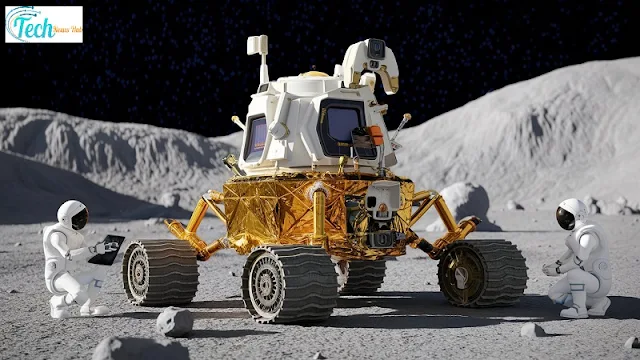Chinese scientists are progressing outlines to develop what they refer to as a lunar surface robot aimed at serving the nation’s future lunar mission known as Chang’e-8 currently slated for 2028. This revolutionary model will not only roam the Moon’s surface but will also also serve as an important feature – that of a roving charging station. This is a part of China’s general space exploration agenda to know more about the lunar environment.
Chinese Scientists Develop Lunar Robot with Charging Functionality for 2028 Mission
Organized by Yu Xiaozhu who is a researcher at both Dalian University of Technology and the Hong Kong University of Science and Technology, the multi-purpose design of the robot is under development. The prototype will come in at around 100 kg, relatively lightweight, but strong enough to stand up to the lunar environment reliably for long periods.
Technically, one of the robot’s main functions will be to be a transport and charging rover for the Chang’e-8 lander. This capability will be crucial to providing other lunar exploration tools as a never-ending source of power and capability to work even if other means of power are not available. This approach aims to overcome one of the main obstacles of long-term lunar exploration: the absence of structure of sustainable energy.
The multifuctional robot will also have the responsability of execute complex experiments. Some will continue to concentrate on the lunar surface makeup, atomic radiation, and other conditions critical for lunar habitats and future lunar exploration. Adapting and functioning independently in such conditions, this robot will demonstrate that China is capable of rapidly improving its space capabilities.
Some of the benefits of this particular robot may help be an important breakthrough of the next lunar and space missions in general and make China among the leaders in space robotics. AS lunar strategist Michael Cook suggests, Orion’s features will create new opportunities for long-term ExIm presence on the Moon in the years to come.
China National Space Administration Approves Lunar Robot for Chang'e-8 Mission
It looks like in China’s next lunar mission, Chang’e-8, CNSA has made the decision of putting a lunar surface robot in the mission. This approval which was declared by the Dalian University of Technology emphasizes the need of the robot in shaping the objective of the mission going towards the moon.
The robot will be a self-driving vehicle for the moon and its uses include pulling power for charging other equipment used in the mission. Promising to be a critical asset on the Chang’e-8 mission that is being planned in China, the platform’s capacity of performing experiments and also observing the health of the Chang’e-8 lander must be highly beneficial for the completion of the mission in the extreme lunar conditions.
Yu Xiaozhu, the research team leader from Dalian University of Technology stressed that the robot would be versatile and thus equipped for both scientific research and operational undertakings. It measures 100 kilograms of mass and designed to endure the lunar environment and supply the mission’s essential energy and information to its systems.
The addition of this robot is significant for Chang’e-8 mission to be launched in 2028 as it is given below. It is also consistent with China’s larger strategic goals of increasing human and robotic missions on the Moon and building the necessary infrastructure for long-term permanent, perhaps even human, settlements.
However, the CNSA has given its stamp to the project, meaning that it is ready to progress to its subsequent stages, and the proposed robot design and testing is believed to be achieved in the following years. Only if such flavors of technology have been integrated properly it could be a precursor for advanced moon missions, and this certainly reinforces China’s dominance in space tourism effectively.
China's Chang'e-7 and Chang'e-8 Missions to Address Lunar Exploration Challenges
The Chang’e-8 mission, together with the Chang’e-7 probe is aimed at establishing a lunar research station, which adds a new level in lunar exploration. It is intended to solve several technical problems that have always existed when it comes to deep-space missions; more so, due to the extremely low temperatures in the region of the Moon’s south pole.
Term and chilly temperature that obtains moon surface: The temperature again becomes very low, reaching almost -200°C This is one of the main problems to which the missions are intended to cater. This therefore calls for research and development of mechanisms, which can be made to work under such conditions to enable efficiency in the equipment used throughout these missions. In response to this, engineers are working on the integral thermal management system that will enable the different components of the mission in the below freezing atmosphere.
Another particularly significant issue is the problem of the navigation and positioning of the robots themselves. Chang’e-8 mission will employ technology that is independent of satellite navigation that is sometimes inaccurate or unavailable in space environment. Hence, the robots that will be used for exploration and other operations during the journey will incorporate rich sensorial data and other complexities of algorithms to enable them traverse the lunar terrain in the best way possible.
The new Chang’e-7 mission, expected to be launched around 2026 will complement the Chang’e-8, more emphasis will be put on the resources in the south pole of the Moon. These missions will be coordinated and will offer precious information necessary for the construction of the new lunar research station as well as for further manned missions on the Moon.
Chang’e-7 and Chang’e-8 are supposed to provide the groundwork for the subsequent stages of China’s lunar exploration program. In terms of meeting key technological issues and enhancing self-contained systems, these missions are fundamental to understanding the appropriateness of a permanent research station relating to the moon.


